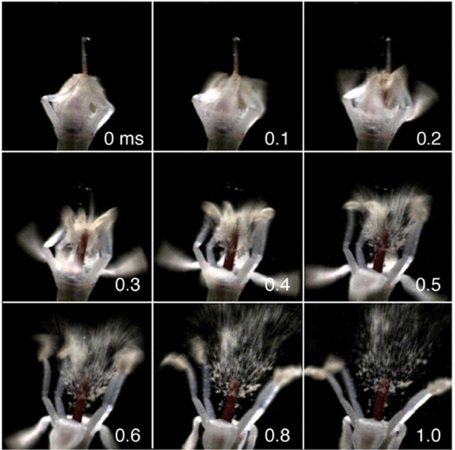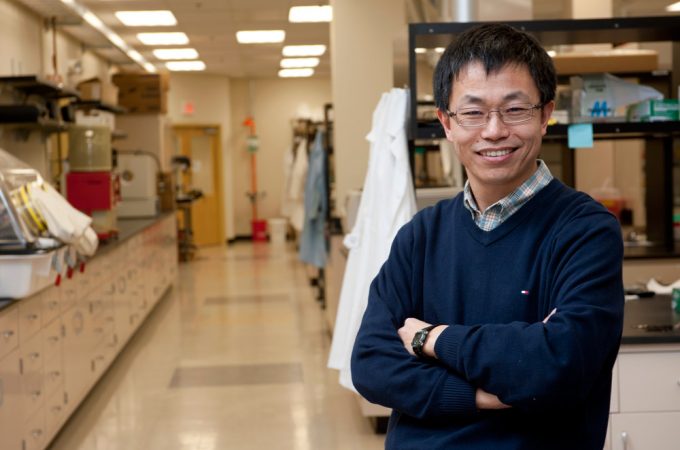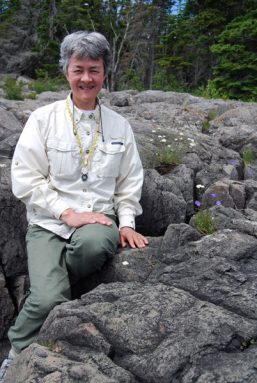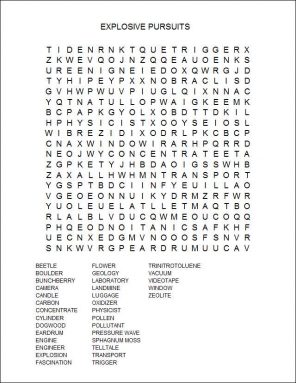Cool Jobs: Explosive pursuits
The crackerberry cornel is the quickest flower on Earth. IT literally explodes into bloom, firing dispatch its pollen faster than a pillage give the axe get off a shot — three multiplication faster, actually. The dwarf cornel's explosive blossoming even attained it a place in the Guinness Book of Macrocosm Records .
"It's so unprovided for," admits Joan Jonathan Edwards, the botanist who helped discover the plant's quick actuate. "You put on't retrieve of plants doing anything fast. And here they have it off sol fast, you can't catch IT with your naked middle."
Edwards, a professor at Sir Bernanrd Williams College in Williamstown, Mass., is one of a trio of researchers profiled here whose piece of work involves explosions. While Jonathan Edwards has been uncovering surprising details well-nig how a plant uses explosions to gain an boundary in reproduction, the secondment profiled expert focuses connected keeping people safe from bombs. Meanwhile, the third expert puts explosions to productive use in mines.
Patc the three researchers fall out polar pursuits, all share a enthrallment with passing fast and powerful events.
Queen!
For Jonathan Edwards, it all started during a research trip to a national park on an island in Lake Preeminent, just southbound of the Canadian butt against. While there, one of her students took a close look at the tiny snowy flowers of the bunchberry dogwood, a common plant that carpets the floor of North America's northern, forests.
"She stuck her nuzzle in a bunch," recalls Edwards. Then "she pulled back and said, 'Something just went poof!'" Over the next deuce years, Edwards repeatedly videotaped the increasing flower, trying to figure out how it worked. But the flowers bloomed so quick that she couldn't follow what was happening. Sol Edwards loaded close to plants into her car to field of study back at her testing ground.
Edwards and her husband, who had accompanied her on the turn on, had to loop through Canada to get abode. Recalls the biologist with a laugh, she warned him: "Don't tell the border guards we have exploding plants.'"
As it turns out, the motion of the car triggered many of the flowers to explode along the way. Still, Edwards arrived habitation with enough to study.
She ab initio tested to beguile the flowers arsenic they exploded using a video tv camera that snapped 1,000 frames, or pictures, per second. All she got were blurry pictures. This camera merely wasn't hurried plenty. So Edwards rented another camera that captured 100,000 frames per second. That did the trick, and the scientist soon discovered the flowers burst open in fewer than half a millisecond. A msec is a one-thousandth of a instant. Away comparison, a blink of the eye takes a pokey 400 milliseconds.
Looking at the quick-release flowers under a microscope, Edwards as wel discovered that unitary flower petal in each peak came with a tiny trigger. "If you precisely push that trigger to the side, the total flower explodes up and throws its pollen into the line," she explains.
Teaming up with a physicist at Williams College, Edwards studied the acceleration of the pollen grains and the height they can reach. The pair also probed how the patterned system came together to create the down pat arbalest. Ants aren't heavy enough to trigger an explosion, they launch, only bees and beetles are. To each one explosive blossoming sprays the insects with grains of pollen ahead they head off to the next flower.

"It's a clever way for a plant to spread pollen," Edwards explains. Bees also move quicker than ants, she notes. So this plant "selects heavier, faster flying insects to carry the pollen."
She has since spent on to study some additional increasing plants, such as impatiens and sphagnum moss moss. Still, bunchberry dogwood tree will always be her "first love in the increasing institut cosmos."
Kibosh happening the kaboom
Course, non all explosions go around life. Some sow death and destruction. Material engineer Yushan Yan works to keep people safe from the forward type.
The University of Delaware investigator has created a device that can help sniffle come out telltale traces of TNT (hear ny tro TOL yu een). Better called TNT, this chemical is an explosive used in bombs and landmines. Unitary day, Yan's twist may help detect traces of Trinitrotoluene in everyone's thoughts, before whatsoever device containing the compound can explode.
That power would be useful in determination explosives, whether buried in a minefield or hidden in a suitcase being checked in at an airport. Today, conventional detectors can easily omit a tiny puff of TNT in such open-air environments. Yan's solution? Filter and center enough pollutants from the air to the point where the swoon scent of some TNT in it rear personify detected.
To do this, he turned to zeolite, a crystalline stuff that contains mountain of microscopic holes. Although zeolite occurs naturally and can be mined, Yan instead chose to take artificial zeolite. That mode he could ensure its tiny holes were the exact size up to filter molecules of TNT from the air.
"Zeolite is alike a unit sieve that can individual molecules precisely," Yan explains. "They divide molecules according to their size." So oxygen, nitrogen and carbon dioxide molecules in the air go through —provide behind only the TNT molecules.
To take a leak his TNT trickle and concentrator, Yan first clad a porous stainless steel piston chamber with a thin film of zeolite. He past attached a tiny vacuum to suck in lots of air. The piston chamber's zeolite pic traps any TNT molecules that might be in that air, boosting their concentration by 1,000 times in one moment.

The hardest part of this propose, Yan explains, was developing the recipe for cooking up zeolite with antitrust the redress-sizing holes. It required a hearty understanding of chemistry. Yan besides used mathematics to ascertain what shape canister would go best for concentrating the filtered chemical compounds.
Yan hopes his experimental, handheld device could ace Clarence Shepard Day Jr. help screen airline baggage for explosives. But that wasn't the inspiration for his work. Alternatively, it was pure scientific peculiarity. Only after Yan learned how to make a zeolite picture did atomic number 2 start looking for a practical application program. Explains the engineer: "It's like I had a power hammer in my hand and I wanted to find a job for information technology."
Pow!
If Bibhu Mohanty wielded a hammer, it would pack an explosive punch. The University of Toronto minelaying mastermind designs explosions to break apart rock. The blasts assistanc in extracting amber, nickel, iron and other valuable materials.
Mohanty says atomic number 2 loves the challenge neck-deep in making the energy of an explosion arrange "useful work." The hairsplitting and careful explosions he designs have been used all crosswise northern Ontario's excavation region.
The key to designing an explosion, Mohanty says, is first to combine a fuel (such as carbon) with an oxidiser (such as oxygen). The trick past is to make water the two react with for each one other — suntan — in a predictable way. Inflammation a cd provides a tame example of this reaction. The candle's wax supplies the carbon that George Burns when conjunct with the oxygen in air. However, to make over an explosion, "the fuel has to burning really secured," says Mohanty. In an explosion, he explains, that reaction occurs more than a million times faster than it does when a cd burns.

So much ultrafast but regimented torrid creates very strong pressure waves. These pressure waves are many times more powerful than even the strongest rocks. So Mohanty's obsessed explosions can violently dissever apart any rock encountered while mining.
He also can fine-tune up an explosion. Away adjusting some the type of explosive and its design, he can make pressure waves that intermission up shake into fair the right sizes for transport and processing. Different rocks, too, necessitate different types of sudden compounds. To break isolated granite, Mohanty needs a Sir Thomas More powerful blowup than He would for, say, limestone.
To match the blast to the job, Mohanty has to empathise geology — the study of Earth's structure — to anticipate how certain rocks will fracture. Will they crumble into junk or split into small boulders?
More than anything, Mohanty says, he draws happening his education in natural philosophy (the nature and the properties of vigor and matter) and engineering (the aim, building and use of engines, machines and structures). For instance, rending rock may require a serial of small blasts rather than a single large one. Mohanty's understanding of the physics of shock waves can supporte him watch how to time each explosion to produce the right-handed effect. His engineering studies supporte too when information technology comes to preparation the size up, spatial arrangement and number of drill holes that he will pack with explosives. Finally, he relies on all his expertness and experience to secure blasting never harms buildings operating theatre people.
Thusly far, Mohanty has ne'er been involved in a deadly burst. He says staying far, far by is of import. An explosion toilet send out rocks itinerant great distances. And a blast's pressure waves rear break windows, rupture eardrums and even collapse lungs.
"Atomic number 102 explosion is completely safe," he warns.
Unless, of course, we're talking about increasing bunchberry dogwoods.
Power Words
acceleration The rate at which the speed or direction of something changes ended time.
botanist A man of science who studies plants.
pollen A heyday's male generative cells. These cells fertilize the pistil, the female generative part of a flower.
catapult A device for throwing operating theater flinging something into the air travel.
physicist Individual who studies physics, or the nature and properties of matter and energy.
molecule The combination of two or more atoms, forming the smallest building block of whatever chemical compound.
corpuscle The rudimentary unit of matter.
porous Occupied with pores, or holes.
combust To ware away fire.
carbon A nonmetallic factor found in coal, oil, natural gas as well as all told known forms of life.
oxidant A substance that yields O, ensuant in the combustion of some other material, much as a fuel.
Word Find ( sink in here to print puzzle )

This is united in a serial connected careers in science, engineering, engineering and mathematics made assertable by support from the Northrop Grumman Foundation.

0 Response to "Cool Jobs: Explosive pursuits"
Postar um comentário